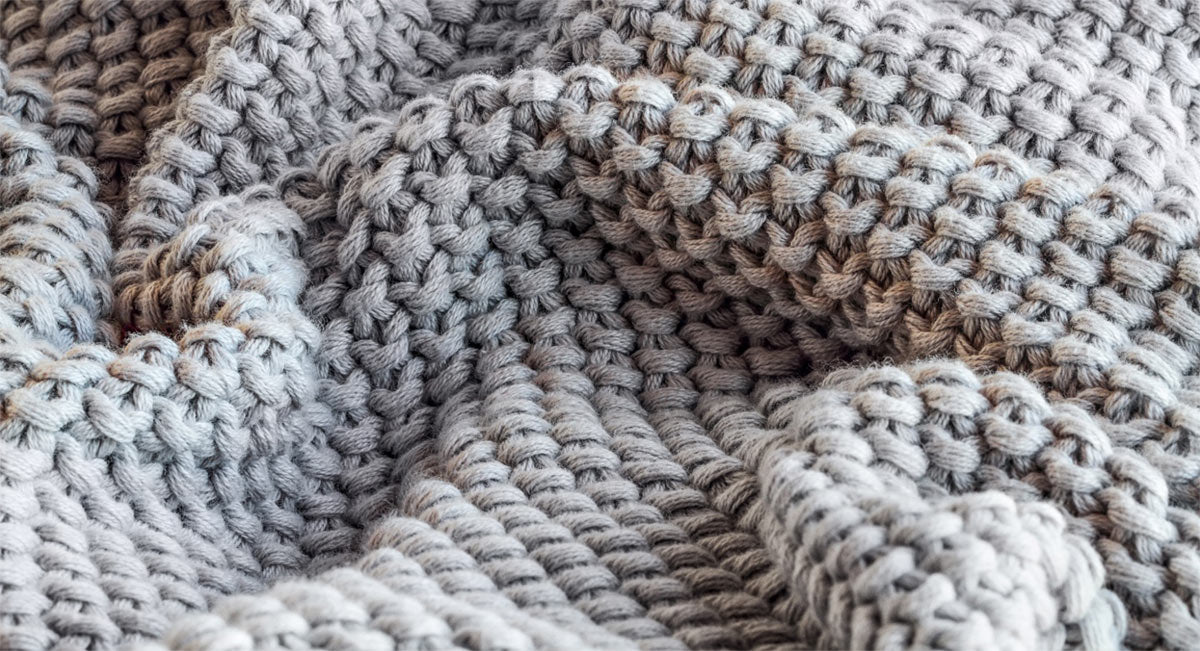
As the seasons transition and the weather grows cooler, there's nothing like wrapping yourself in a warm, cozy blanket. Knitting your blanket can be rewarding and enjoyable, allowing you to customize the size and design to suit your preferences. This blog post will explore three delightful blanket knitting patterns perfect for the changing seasons. These are easy patterns that even beginners can follow once they know their basics. If you plan to knit a chunky wool blanket this winter, follow our previous guide on the topic.
Planning your blanket
Now, blanket knitting is reasonably easy in construction and design but very laborious and time-consuming. The first thing to decide upon is the size. A standard throw blanket size is around 50 inches by 60 inches, but you can adjust it according to your preference. You can work out a lap blanket or one customized for your sofa or couch.
You can opt for a pair of single-pointed needles and make the pattern in pieces, or choose the right size and length of circular knitting needles. With circulars, you benefit from a rather long needle length that can accommodate stitches in hundreds. Also, the ergonomic design allows the weight of the project to stay on the cord on your lap, reducing stress and fatigue on your hands.
Besides knitting needles, keep your knitting accessories close at hand—stitch markers, finishing needles, a repair hook, sharp scissors, and other essentials.
You can use yarn for your blanket to suit your requirements. You can choose from DK weight or worsted weight yarn to bulky to chunky weights of yarn, Work with your stash if you have a lot of yarn left from your previous projects. This is a good time and project to get done with your stash. If you are following a pattern, then simply follow the yarn instructions. First, knit a gauge swatch and complete your calculations if you want to substitute yarn.
So, let’s get started.
Option 1: Use Colorful Wool in the Garter Stitch Pattern
Knitting a blanket in the garter stitch pattern is an excellent choice if you're looking for a quick and satisfying project. The garter stitch is one of the most straightforward and most beginner-friendly knitting patterns, making it perfect for those new to knitting and seasoned knitters alike. You simply knit every stitch, every row. Unlike the Stockinette stitch pattern, it does not tend to curl at the edges.
Working with multiple colors adds to its appeal. Like the changing season, use shades according to the weather. If you have a stash of multiple yarns, now is the time to utilize it.
Instructions:
Cast On: Using a long-tail cast-on method, cast on the desired number of stitches for the width of your blanket. Our guide on 5 methods to calculate yarn needed for long-tail cast-on will help you get the right length of yarn so that you stay supplied and get a long tail to weave in later.
Knit in Garter Stitch: Once you have cast on your stitches, simply knit every row (no purling required) until your blanket reaches the desired length. This creates a beautiful and squishy texture that's incredibly warm. You can change the colors of the yarn after a few rows. If you are a free spirit, work with the yarn till it lasts and then make a change.
Bind Off: When your blanket is the desired length, bind off all stitches and cut the yarn, leaving a tail for weaving in.
Finishing: Weave in any loose ends using a finishing needle, and your garter stitch blanket is ready to keep you warm.
Option 2: Work with Cables
Cabled blankets are not only visually stunning but also incredibly warm and luxurious. The intertwining patterns of cables create a rich texture perfect for snuggling under on chilly evenings. If you are new to cables, our guide to cable knitting patterns will walk you through making the interesting stitch pattern.

Instructions:
Choose a Cable Pattern: Select a cable pattern that you like. There are countless cable patterns available in knitting books and online resources. Ensure that the pattern is suitable for a blanket. You work with knit and purl stitches but work them out of turn by putting them on a cable needle. Some cable knitting patterns do not require a cable needle and can be worked without one.
Cast On: Cast on the desired number of stitches for your blanket width.
Knit the Cable Pattern: Follow the cable pattern instructions carefully. Typically, cable patterns involve a combination of knit, purl, and cable stitches. Use a cable needle to hold stitches while you work the cable crosses.
Repeat Rows: Repeat the cable pattern rows until your blanket reaches the desired length.
Bind Off: When your blanket is the right size, bind off all stitches and cut the yarn, leaving a tail for weaving in.
Finishing: Weave in any loose ends using a tapestry needle. Your cabled blanket is now ready to provide warmth and beauty to your space.
Option 3: Work with Colorful Mitered Squares
Mitered square blankets are a creative and visually appealing way to play with colors and shapes. By knitting individual squares and joining them together, you can create a unique and eye-catching blanket that's perfect for any season. The most significant advantage of a mitered square blanket is that you can work on mitered squares in your spare time. You can work them on a pair of single pointed needles or any length of circulars. You can utilize your yarn stash and make colorful squares.
Instructions:
Start with deciding on the size of your mitered squares. A standard size is 4 inches by 4 inches, but you can adjust it to your preference. Knitting a mitered square is making one project at a time.
- Cast On: Cast on stitches for one side of the square.
- Decrease Rows: Knit across the first row, and then begin decreasing at the center of each row by knitting two stitches together (k2tog) or using a slip-slip-knit (ssk) decrease until you have one stitch left.
- Bind Off: Bind off the remaining stitch.
Make as many squares as needed to achieve your blanket's desired width and length.
Arrange and Join Squares: Lay out your mitered squares in a pleasing pattern. You can use a simple grid or get creative with your arrangement.
Join the Squares: Seam the squares together using a preferred method, such as mattress stitch or slip-stitch crochet. Be sure to secure the squares firmly for durability.
Finishing: Weave in any loose ends with a finishing needle. Your colorful mitered square blanket is ready to add a burst of color to your living space.
In conclusion, knitting a cozy blanket is a delightful way to embrace the changing seasons and add a personal touch to your home decor. Whether you choose the simplicity of garter stitch, the elegance of cables, or the creativity of mitered squares, each pattern offers a unique knitting experience that will result in a beautiful and functional addition to your home. To make your projects enjoyable, you can explore colorwork knitting techniques. Our guide to introducing colors to knitting patterns with 7 popular methods will walk you through.
So, gather premium knitting needles from the Lantern Moon Collection, select your favorite yarn, and create your own warm and comforting blanket. The handcrafted tools, including cases of sets and accessories, are made by skilled artisans. The liquid silk finish of ebony wood offers a smooth crafting experience.
Happy blanket knitting!
